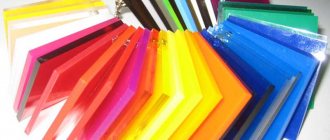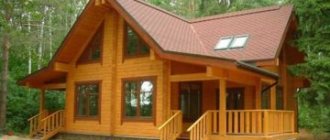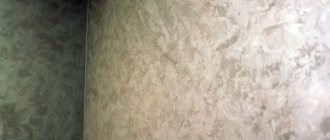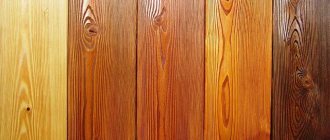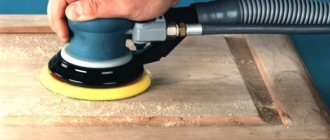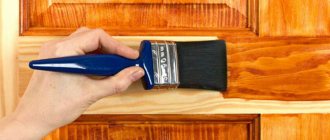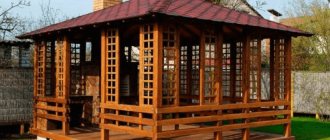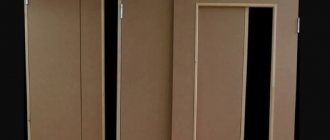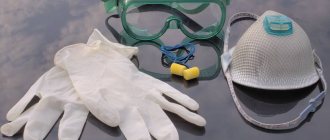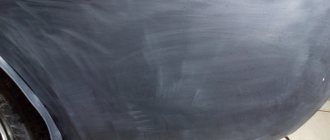A wooden block house has many advantages. Houses whose facades are covered with this material have a very presentable appearance. But wood also has its drawbacks. A block house may be attacked by wood beetles or house fungus. In order to protect the material and extend its service life, it is necessary to impregnate or paint the block house with special compounds.
Antiseptic "Senezh Aquadecor" is designed to protect the block house from precipitation, mold, and woodworms.
Do I need to paint the block house?
Houses made from this material have many advantages, due to which they become popular. The block house has an attractive, aesthetic appearance.
Natural wood, which is the basis for finishing, must be protected from the appearance of fungus and attacks by wood parasites. Impregnation or other special compounds will extend the life of natural wood.
Required tools and materials
Before processing, you will need to level the surface, remove nails, remove joints and chips. To do this you will need to stock up on primer. If this is not done, after some time traces of rust may appear on the surface, which will certainly spoil the appearance.
To apply impregnations and paints, you will need to prepare a roller or a special spray bottle.
It is better to paint all joints and seams with a brush, but this should only be done in the longitudinal direction.
For preliminary preparation of natural wood, you will need brushes with hard bristles.
To effectively paint the end sections and reliably protect the surface from damage and harmful environmental factors, special sealants will be required.
How to prepare the surface?
Is it necessary to paint a block house and how to make high-quality preparation for work? Before treating the surface, thoroughly clean it from dust, dirt and remnants of old materials. The process is carried out with special steel brushes or a grinder.
If there are areas with mold on the facade of a block house, it must be thoroughly cleaned and then treated with bleaching agents. For this purpose, special stains for lightening are offered.
Rollers and brushes are used to apply the final coating. The brush provides precise access to hard-to-reach areas. But painting with a roller or spray is much easier and faster.
Transparent compounds
Protective transparent azures, varnishes, are a solution that will not only preserve the finishing material for a long time, but also preserve the natural appearance of a wooden block house. Products without color can be used to treat a block house not only outside the house, but also inside.
When working indoors, it is recommended to apply 2 times less layer of varnish.
Impregnation
To eliminate parasites, mold and other unpleasant phenomena, impregnations are the most effective. According to classification they are offered:
- Oil based (based on linseed oil).
- Acrylic water soluble.
- Alkyd (with alkyd resins).
Transparent impregnations have the following characteristics:
- Antiseptic.
- Fire retardant.
- Bioprotective.
These properties provide the following characteristics:
- Protection of the block house from mold and mildew, damage by harmful insects.
- Prevents the appearance of darkening and blue areas.
- Reduces the formation of chips and cracks on the surface.
- Increase the period of operation.
In addition, transparent impregnations are a universal base for decorative painting.
Stains and varnishes
If you need to paint natural wood, so as not to distort the natural color and pattern, special stains and varnishes are offered. The composition of these products effectively protects the block house and preserves its naturalness.
When dealing with the issue of painting a block house, you must adhere to the following recommendations:
- Before carrying out the procedure, the surface must be prepared, cleaned of dust, and if necessary, dried.
- Prepare in advance a foam roller or brush for painting the house block.
- Initially, you need to apply a thin layer of tinting product.
- For the first layer of indoor treatment, it is recommended to use one-component stains or varnishes.
- Indoors, for high-quality protection, only 2 layers of a transparent product will be enough.
- For exterior work, two-component house block paint should be used.
- The exterior of the building is treated with a double layer of varnish.
Lazuri
The peculiarity of using azure is that it is a universal product that combines the features of impregnations and the advantages of varnishes. Lazuries are also called glazing agents.
Thanks to their combined properties, glazes simultaneously take good care of the wood and give an interesting, sophisticated appearance to the surface.
The assortment includes the following glaze compositions:
- Tinted.
- Alkyd.
- Alkyd oil.
- Alkyd-urethane.
- Matte.
- Glossy.
To add texture to the surface of the house block, glazes are used, which allow the natural material to be tinted in any shade.
For protection you will need at least 3 layers of the composition, which can be conveniently applied with foam rollers or oil brushes. Sprayers can be used for processing, but this requires some experience. If you don’t have the skills, it’s better to use the services of specialists; the price of the work will depend on the area of processing.
The undoubted advantage of azure is the combination of high quality, affordable cost and the ability to extend the service life of the block house for a long time.
How to paint a block house outside and inside
When buying a wooden block house, keep in mind that, like any wooden product, this type of finishing must be protected from exposure to weather conditions, fire and microorganisms. Only in this case can you count on a long service life of the block house. How to paint a block house on the outside, and what on the inside?
Block house - does it need to be painted?
The answer to this question may vary in each individual case. It all depends on the manufacturer’s responsibility for its products and its capabilities. A wide range of different impregnations and paint and varnish compositions allows you to protect wood from the effects of any natural phenomena, be it fire or water. All of them are available to a wide range of consumers, but consumers are deprived of the opportunity to process wood professionally, as is done in industrial production.
What is the difference between industrial painting of a block house? At enterprises, the composition is not simply applied to the surface, as we do at home, but is impregnated with the composition in special autoclaves, inside of which a vacuum environment or high pressure can be created. The blanks are first cleared of bark and bast and immersed in an autoclave.
This unit is a huge sealed container. First, air and residual moisture remaining in the capillaries are removed from the block house under vacuum. Then chemical compounds for treatment are poured into the chamber and pressure is built up. In this state, the workpieces are kept for quite a long time - for spruce or fir the exposure will last about 7 hours, for birch 3.5 is enough. Manufacturers also take into account what part of the wood is in the pressure chamber - if it is the core, then it takes more time to impregnate it, if it is sapwood (a layer of lighter-colored wood near the bark), then the material is more susceptible. The required impregnation depth is from 2 mm to 5 mm, depending on the type of wood.
After keeping the workpieces in the solution, the liquids are pumped out and a vacuum is created again, due to which excess moisture and chemicals leave the surface of the wood. The material is kept for some time under normal conditions so that the preservative liquids are fixed.
As a result of such deep processing, even inexpensive species like pine acquire the qualities of hardwoods like oak or beech.
They resist fire more effectively and are practically not subject to rotting. It is almost impossible to achieve the same results at home. You can distinguish a high-quality block house from an ordinary one by the end of the product - if you cut a board, then by the end part you will see how deeply the impregnation has penetrated. Objectively speaking, not all manufacturers are able to provide such treatment - small private firms mainly make do with surface impregnation, and some even sell the material, worrying only about giving it the desired shape. Therefore, knowledge of how to paint a block house to decorate the walls outside will certainly not hurt you.
How to paint a block house outside - compositions
Modern means for processing wooden materials often have combined properties. For example, in addition to antiseptic qualities, the composition you purchased can also protect the tree from moisture, repel wood borers, reflect ultraviolet radiation, and even give the wood a beautiful color or gloss. The natural texture of wood is best emphasized by oil compositions, which also give it dirt-repellent properties.
The most common formulations on the market are:
- Water-soluble impregnations with an acrylic component, which are used to treat fresh wood. Since they do not have a sharp, unpleasant odor and do not emit dangerous toxins, they are used for interior work in rooms where people live or work, for example, when finishing a balcony. However, it should be borne in mind that these compositions create a rather short-lived and not very durable wood coating.
- Alkyd impregnations are the complete opposite of acrylic ones. They have an unpleasant, pungent odor that can easily give you a headache, so work should be carried out in empty rooms. But the impregnated layer of wood acquires high mechanical qualities.
- Oil impregnations are made from natural oils with the addition of solvents. They are recommended for finishing a block house located outside.
Coating a block house with varnish for exterior finishing is unwise, since such compositions, unlike impregnations, are not absorbed into the wood, but create a membrane on its surface. This membrane should protect the wood from mechanical influences - impacts, friction, scratches. However, varnishes are basically powerless against atmospheric phenomena.
They are not sealants, although they have moderate water-repellent properties, but if oils and other impregnations do not prevent the evaporation of moisture, then the varnish membrane does just that. Moisture accumulates under the membrane and has a destructive effect on both the wood and the varnish itself. In a word, such coverage will do more harm than good.
In this case, what is the best way to paint a block house in order to achieve the shine of the varnished surface? Pay attention to the so-called azures, or glazing compounds. This is something between impregnations and varnishes - on the one hand, they add shine to the surface, favorably highlight the pattern and texture, and on the other hand, they maintain the permeability of the surface, thanks to which the wood can freely evaporate excess moisture. In addition, such impregnations have protective properties against moisture and ultraviolet radiation.
Some compounds are very dense and do not leave smudges, so treatment can be carried out after installation of the block house. Glazes can also be tinted to give the wood the shade you want. Conduct an experiment first - dilute a few drops of tint in a small amount of azure, apply the composition to a piece of trim and wait until it dries completely. It is quite possible that the shade declared by the manufacturer and the one you receive will actually differ, like green from red.
Depending on the components, glazes are also divided into acrylic, alkyd and alkyd-urethane. The latter are considered the most effective - the urethane component gives the impregnated surface greater resistance to damage. Such compositions can be used for both external and internal work.
It is up to you to decide whether it is worth covering the block house with paints that create a colored membrane on the surface, but in most cases, with such treatment, the texture of the wood is lost, and in addition, returning to the original state of the wood will be very difficult - as they say, there is no turning back.
However, if for some reason you decide to decorate with paints, then first the wood should be primed with a special primer or the same paint diluted to the point of impregnation. Thanks to this, the surface will be more susceptible to the composition. Paint for a block house must have good water-repellent properties and withstand exposure to ultraviolet radiation.
How to paint a block house outside - surface preparation
Whatever composition you choose, before painting the block house, you must definitely follow the procedure for preparing the material. The wood must be cleaned of remnants of previous compounds, if any, as well as dirt and dust. Cleaning is carried out using grinding machines, steel brushes or, in extreme cases, a knife.
Mold-covered and darkened areas should be pre-treated with bleaching compounds - this is if you want to emphasize the texture of the wood. If you cover the material with colored paint, then these imperfections will be reliably hidden from human eyes.
It is most convenient to work with a block house using two tools at once - a roller and a brush. A large area is treated with a roller at once, while with a brush the coloring composition is applied to hard-to-reach places. Prepare enough rags and a paint bath for work so that it is convenient to apply the composition to the roller.
Opaque formulations
To stylize the appearance of the building’s façade and to give the interior a certain “zest,” you can use textured opaque compounds.
Water-soluble paints
When treating the surface of a block house, water-soluble compositions can give it the following colors and shades:
- Nut.
- Oak.
- Ripe cherry.
- Red tree.
- Maple.
- Lemon.
Water-soluble compositions are not as durable as analogue paints or varnishes, but they are much more environmentally friendly and safer. Due to this, water-soluble paints are preferred for indoor use.
Organic solvent based paints
Protective compounds developed on the basis of organic solvents can be of the following types:
- Acrylic.
- Alkyd.
- Polyurethane.
- Enamel.
- Oily.
Paints based on organic bases differ from analogue offerings in their high quality of coating. It is very convenient to work with them inside the house, for example, on the balcony, in living rooms.
But, despite this, paints based on organic solvents erase the natural imitation of wood, and the individual feature of the block house is lost.
Russian, Finnish and Swedish folk remedies
Different countries have their own characteristics of construction and subsequent maintenance of buildings. Folk recipes for processing block house have proven reliability over hundreds of years.
Russian recipe
In Russia, wooden houses have been built for many centuries, so over the years, many effective and simple recipes for caring for wood have accumulated in the arsenal.
The walls of houses are covered with lime-based products, and clay compositions are also used.
The clay-salt-water solution is very popular. It is suitable for processing wooden surfaces:
- Prepare the ingredients clay, salt and water.
- For the solution, take 74 parts clay, 4 parts salt.
- Add water in such quantity to obtain the consistency of thick sour cream.
After this, brush the block house with a thin layer, wait until it dries completely, apply the 2nd layer.
Finnish recipe
The Finns do not lag behind in house construction methods; they also have high-quality and reliable methods of caring for natural wood. One of these recipes:
- Combine 720 g of rye flour and 1.5 kg of iron sulfate in one container.
- Add 360 g of kitchen coarse salt and 1.5 kg of dry lime to the mixture.
- Dilute the resulting dry mixture in 6 liters of water.
- Strain and put the mixture on low heat.
- Bring to a boil and stir constantly to form a creamy paste.
- Boil 3 liters of water and carefully add to the paste.
The consumption of the protective mixture is 300 g per 1 sq.m.
The Finns also offer a variety of high-quality and effective ready-made compositions, for example, Tikkurila varnishes or the glazing antiseptic composition Valti Color Satin.
Swedish recipe
The protective composition from the Swedes is very similar to the Finnish adjusted recipe. Swedish experts assure that you should never deviate from the recipe:
- Combine 600 g of rye flour and 250 g of table salt.
- Add 250 g of iron sulfate, 250 g of drying oil, mix thoroughly.
- Add 250 g of red lead and 4.5 liters of water into the mixture.
If you want to give a natural wood façade an interesting shade, you can add a dry coloring pigment to the composition. Without coloring additives, the composition has a yellow tint.
Prepare a lump-free paste over low heat, stir until all ingredients have dissolved.
Under no circumstances should the solution be applied to finishing wood while it is hot; it must first be allowed to cool. For application it is better to use a wide brush, the approximate consumption is 230-250 g per m2. Apply the composition to the house block in 1 layer.
A block house is an inexpensive opportunity to change the aesthetic interior and exterior of any home. Thanks to high-quality care, the walls of the facade or interior will acquire natural warmth and naturalness. Much depends on the quality of the chosen protective composition, proper surface treatment and systematic maintenance.
Many products can not only carefully protect wood, but also, thanks to the presence of pigment, impart an original shade and texture.
How to paint a block house: outside, the best options
Block House, like any wooden product, requires constant care and protection from aggressive factors. When choosing natural wood for decoration, you need to choose how to paint the house block outside and inside?
Do I need to paint the block house?
Houses made from this material have many advantages, due to which they become popular. The block house has an attractive, aesthetic appearance.
Natural wood, which is the basis for finishing, must be protected from the appearance of fungus and attacks by wood parasites. Impregnation or other special compounds will extend the life of natural wood.
Required tools and materials
Before processing, you will need to level the surface, remove nails, remove joints and chips. To do this you will need to stock up on primer. If this is not done, after some time traces of rust may appear on the surface, which will certainly spoil the appearance.
To apply impregnations and paints, you will need to prepare a roller or a special spray bottle.
It is better to paint all joints and seams with a brush, but this should only be done in the longitudinal direction.
For preliminary preparation of natural wood, you will need brushes with hard bristles.
To effectively paint the end sections and reliably protect the surface from damage and harmful environmental factors, special sealants will be required.
How to prepare the surface?
Is it necessary to paint a block house and how to make high-quality preparation for work? Before treating the surface, thoroughly clean it from dust, dirt and remnants of old materials. The process is carried out with special steel brushes or a grinder.
If there are areas with mold on the facade of a block house, it must be thoroughly cleaned and then treated with bleaching agents. For this purpose, special stains for lightening are offered.
Rollers and brushes are used to apply the final coating. The brush provides precise access to hard-to-reach areas. But painting with a roller or spray is much easier and faster.
Transparent compounds
Protective transparent azures, varnishes, are a solution that will not only preserve the finishing material for a long time, but also preserve the natural appearance of a wooden block house. Products without color can be used to treat a block house not only outside the house, but also inside.
When working indoors, it is recommended to apply 2 times less layer of varnish.
Impregnation
To eliminate parasites, mold and other unpleasant phenomena, impregnations are the most effective. According to classification they are offered:
- Oil based (based on linseed oil).
- Acrylic water soluble.
- Alkyd (with alkyd resins).
Transparent impregnations have the following characteristics:
- Antiseptic.
- Fire retardant.
- Bioprotective.
These properties provide the following characteristics:
- Protection of the block house from mold and mildew, damage by harmful insects.
- Prevents the appearance of darkening and blue areas.
- Reduces the formation of chips and cracks on the surface.
- Increase the period of operation.
In addition, transparent impregnations are a universal base for decorative painting.
Stains and varnishes
If you need to paint natural wood, so as not to distort the natural color and pattern, special stains and varnishes are offered. The composition of these products effectively protects the block house and preserves its naturalness.
When dealing with the issue of painting a block house, you must adhere to the following recommendations:
- Before carrying out the procedure, the surface must be prepared, cleaned of dust, and if necessary, dried.
- Prepare in advance a foam roller or brush for painting the house block.
- Initially, you need to apply a thin layer of tinting product.
- For the first layer of indoor treatment, it is recommended to use one-component stains or varnishes.
- Indoors, for high-quality protection, only 2 layers of a transparent product will be enough.
- For exterior work, two-component house block paint should be used.
- The exterior of the building is treated with a double layer of varnish.
Lazuri
The peculiarity of using azure is that it is a universal product that combines the features of impregnations and the advantages of varnishes. Lazuries are also called glazing agents.
Thanks to their combined properties, glazes simultaneously take good care of the wood and give an interesting, sophisticated appearance to the surface.
The assortment includes the following glaze compositions:
- Tinted.
- Alkyd.
- Alkyd oil.
- Alkyd-urethane.
- Matte.
- Glossy.
To add texture to the surface of the house block, glazes are used, which allow the natural material to be tinted in any shade.
For protection you will need at least 3 layers of the composition, which can be conveniently applied with foam rollers or oil brushes. Sprayers can be used for processing, but this requires some experience. If you don’t have the skills, it’s better to use the services of specialists; the price of the work will depend on the area of processing.
The undoubted advantage of azure is the combination of high quality, affordable cost and the ability to extend the service life of the block house for a long time.
Opaque formulations
To stylize the appearance of the building’s façade and to give the interior a certain “zest,” you can use textured opaque compounds.
Water-soluble paints
When treating the surface of a block house, water-soluble compositions can give it the following colors and shades:
- Nut.
- Oak.
- Ripe cherry.
- Red tree.
- Maple.
- Lemon.
Water-soluble compositions are not as durable as analogue paints or varnishes, but they are much more environmentally friendly and safer. Due to this, water-soluble paints are preferred for indoor use.
Organic solvent based paints
Protective compounds developed on the basis of organic solvents can be of the following types:
- Acrylic.
- Alkyd.
- Polyurethane.
- Enamel.
- Oily.
Paints based on organic bases differ from analogue offerings in their high quality of coating. It is very convenient to work with them inside the house, for example, on the balcony, in living rooms.
But, despite this, paints based on organic solvents erase the natural imitation of wood, and the individual feature of the block house is lost.
Russian, Finnish and Swedish folk remedies
Different countries have their own characteristics of construction and subsequent maintenance of buildings. Folk recipes for processing block house have proven reliability over hundreds of years.
Russian recipe
In Russia, wooden houses have been built for many centuries, so over the years, many effective and simple recipes for caring for wood have accumulated in the arsenal.
The walls of houses are covered with lime-based products, and clay compositions are also used.
The clay-salt-water solution is very popular. It is suitable for processing wooden surfaces:
- Prepare the ingredients clay, salt and water.
- For the solution, take 74 parts clay, 4 parts salt.
- Add water in such quantity to obtain the consistency of thick sour cream.
After this, brush the block house with a thin layer, wait until it dries completely, apply the 2nd layer.
Finnish recipe
The Finns do not lag behind in house construction methods; they also have high-quality and reliable methods of caring for natural wood. One of these recipes:
- Combine 720 g of rye flour and 1.5 kg of iron sulfate in one container.
- Add 360 g of kitchen coarse salt and 1.5 kg of dry lime to the mixture.
- Dilute the resulting dry mixture in 6 liters of water.
- Strain and put the mixture on low heat.
- Bring to a boil and stir constantly to form a creamy paste.
- Boil 3 liters of water and carefully add to the paste.
The consumption of the protective mixture is 300 g per 1 sq.m.
The Finns also offer a variety of high-quality and effective ready-made compositions, for example, Tikkurila varnishes or the glazing antiseptic composition Valti Color Satin.
Swedish recipe
The protective composition from the Swedes is very similar to the Finnish adjusted recipe. Swedish experts assure that you should never deviate from the recipe:
- Combine 600 g of rye flour and 250 g of table salt.
- Add 250 g of iron sulfate, 250 g of drying oil, mix thoroughly.
- Add 250 g of red lead and 4.5 liters of water into the mixture.
If you want to give a natural wood façade an interesting shade, you can add a dry coloring pigment to the composition. Without coloring additives, the composition has a yellow tint.
Prepare a lump-free paste over low heat, stir until all ingredients have dissolved.
Under no circumstances should the solution be applied to finishing wood while it is hot; it must first be allowed to cool. For application it is better to use a wide brush, the approximate consumption is 230-250 g per m2. Apply the composition to the house block in 1 layer.
A block house is an inexpensive opportunity to change the aesthetic interior and exterior of any home. Thanks to high-quality care, the walls of the facade or interior will acquire natural warmth and naturalness. Much depends on the quality of the chosen protective composition, proper surface treatment and systematic maintenance.
Many products can not only carefully protect wood, but also, thanks to the presence of pigment, impart an original shade and texture.
What is the best way to paint a block house: or how to avoid problems?
Are you wondering how to paint a flea house? We are leaning towards butter, and in this article we will try to defend our point of view.
Most often, block houses are used for exterior decoration. It gives the facade an aesthetic, beautiful appearance in the style of country or Russian hut. The block house is very convenient to use for the restoration of buildings that have lost their appearance, but have already taken on a classic Russian look.
Paint that has protective properties against atmospheric agents and damaging ultraviolet radiation, and protects against mold and blue stains will be considered correct and suitable for such types of work.
First of all, the block house is a fairly large profile, which means that when drying, the moisture does not completely leave the wood and during operation the drying process continues for some time. And this is fraught with destruction of the paint film during operation. Therefore, you need to use compounds that allow the wood to breathe.
Photo 1. Decorating the outside of a wooden house with a pine block house
What is the best way to paint a block house?
If you coat such a material with acrylate compounds that form a porous film on the surface, you can safely count on a 6-8 year service life. For example, Teknos is an elite varnish scheme that will serve you faithfully for many years. In our paint shop we have been using this material to paint block houses for many years!
Remember that painting a house block begins with preliminary preparation of the surface of the board. We are talking about grinding with abrasive (80 grit) to open the pores. If the house block is of small thickness and width, then more abrasive is needed (at least 150), otherwise large grains can damage the thin chamfer, and the panels may partially lose their convex shape.
Then don’t forget about the adhesive alkyd-acrylate primer. The primer from Teknos and the Renner impregnation containing fungicides have proven themselves well, which not only penetrate deep into the wood pores opened by sanding, but also protect against fungus and mold.
By the way, what I wrote above is a fact. This spring I hung two stands on the street. One was treated with a primer and varnished, the second was coated in two layers with acrylate glaze and tinting. By autumn, a slight blue discoloration appeared on the pine under the azure, the growth of which stopped with frost, and no changes were observed on the shield treated with an antiseptic.
Next is removing the lint. The antiseptic primer composition is aqueous and it raises the pile significantly. To achieve a high-quality surface and a beautiful appearance, after applying the first layer of varnish, it is necessary to knock down the pile with an abrasive stone. The varnish “glazes” the pile and it comes off very simply, with light movements.
Well, the final stage is applying a second layer of acrylic varnish. If these conditions are met, you can count on the quality of the painted block house as in the photo below. It can safely be called furniture. See how the color-setting primer highlights the wood texture.
Photo 2. Imitation of logs
Photo 3. Teknos coatings
And if you use alkyds, then due to their low elasticity, the natural processes of changing the geometry of the wood will cause cracking of the paint over time. A sad sight. Re-sanding is very labor-intensive. If you want to paint a house block with opaque paint, then choose acrylates, for example Nordika Eko.
Unlike alkyds and acrylates, oil penetrates deeply into the upper layers of wood, leaving a porous and breathable film on the surface. It does not collapse or crack, as if it lives and breathes with the tree.
Why is the oil convenient to use?
Because it is not difficult to apply, there will be no streaks left from the brush. If you notice any defect in the application, it is easy to fix. To update after 6-8 years, you just need to wash the facade with Karcher and apply one coat of oil.
There are two things you need to know when working with oils. First, the oil lasts 4-6 years without prior application of an antiseptic. To double the service life, an antiseptic is needed. Secondly, oil is good, but hydraulic oil is much better. And why?
Let's imagine a situation where you paint or renew a façade with natural linseed oils. This oil takes more than a day to dry without touching, which means that dust raised by the wind can completely ruin the aesthetic side of your work.
The situation is different. We paint with oil not on the facade, but on the ground. How to dry panels that take a day to dry between coats? Okay, we figured out how. Next, the carpenters begin to install the panels on the façade. And even after a week they will stain a little when you press them with your finger. These same fingers will remain on the façade after the installation of the oil-painted block house.
Renner hydraulic oil. More than one house was painted. We painted both on site and in the workshop. Dries completely in 2 hours. It lasts no less than any linseed oil, any super brands you find on the market. We saw not only a block house painted with hydraulic oil, we even saw a pier, which was periodically flooded with water and continued to serve. In our practice, we have never seen a more easy-to-use and functional paintwork material.
Photo 4. Decorating a block house made of AB grade pine
Which oil do professionals choose?
The Italian company Renner, which recently appeared on the Russian market, has fully met the expectations of professional painters. Easy to apply, long lasting pigments, fast drying and long lasting.
On our website you can get acquainted with the line of this manufacturer and select the paints necessary for painting a house block.
See how we can
How to paint a block house inside and outside a country house: questions and answers
Cladding a house with a beautiful and inexpensive block house is a win-win option for finishing any building. Connoisseurs of natural wooden surfaces prefer this material for its versatility. The illusion of a log house looks great indoors and decorates the outside, but like any wood, it requires additional protection.
Protective and decorative solutions help maintain the attractiveness and increase the service life of the material. These include various impregnations, varnishes, azures and blockhouse paint. To unlock the potential of a planed board and highlight its beauty, you need to choose a protective composition that is suitable for the type of wood used.
Features of block house processing
Many manufacturers sell already processed material. Protective compounds are applied during industrial painting in special autoclaves. This is a very complex technological process. Factory processing is done very high quality, but the processed block house is more expensive.
If it is not possible to purchase material at a high price, you can buy raw material and process it yourself. There is nothing complicated about this procedure. The main thing is to know its properties, choose the composition suitable for processing and have basic painting skills.
It is important to know! It is made from coniferous and deciduous trees. Each of them reacts in its own way to moisture, ultraviolet rays, pests and mechanical stress. When deciding how to cover a block house, study the properties and characteristics of the wood used and only then buy protective processing and painting products.
Properties and types of protective impregnations
To increase the service life of the blockhouse, impregnations can be used. All existing protective compounds emphasize the natural attractiveness of the material and improve its performance.
Impregnating agents protect against mold, darkening, drying out, the appearance of fungus and other inevitable influences. Impregnating compositions are divided into the following groups:
- Antiseptics prevent the appearance of mold, rot and fungi, and repel rodents.
- Fire retardants form a special film on the surface, which reduces the likelihood of fire.
- Waterproof ones prevent the penetration of moisture.
- Combined ones combine most of the protective properties.
The last type, multifunctional (combined) impregnations, is the best option for a residential building. Complex (antiseptic, water-repellent and fire-retardant) action provides complete protection. Such compositions are used as an independent coating or as a basis for finishing.
Important! Before treating a blockhouse, it is necessary to determine the desired effect, that is, to study such characteristics of coloring agents as transparency. If you want to emphasize its structure, purchase transparent coatings, and vice versa, you can hide the pattern with opaque means.
Oil formulations
If it is necessary to add a color tint, impregnations containing oils are used. Such natural paints are made based on alkyd and acrylic components. They have a dirt-repellent effect, provide a stable and durable coating, but there is a drawback: oil impregnations take a long time to absorb and dry.
When using them, the texture of the wood is lost, so staining is used to purposefully change the color of the block house.
Varnishes and paints
The varnishes are colorless, they only slightly change shade. When choosing these compositions, keep in mind that varnishing and painting a blockhouse can cause some problems. When applying products, a dense film is formed on the surface, which over time can crack, peel off and become unusable.
Lazuri
Impregnating azures are considered the best option for processing and protecting block houses. Impregnations are tinted in a variety of shades and make it possible to turn inexpensive types of wood into valuable species. Depending on the components, the following types are distinguished:
- alkyd
- alkyd-urethane
- alkyd-oil
- acrylic-oil
Azures are very elastic, have antiseptic properties and prevent the appearance of defects on the coating. Glaze emphasizes the natural patterns of wood better than other means. Such compositions remain transparent, but have certain shades, the saturation of which depends on the number of layers applied.
External and internal finishing. How to choose the right composition?
Before painting the outside of the house block, make sure that the selected composition is suitable for exterior work. It is very important to provide maximum protection from atmospheric and mechanical influences. Combined mixtures are ideal. These can be oil compositions and azures. They favorably emphasize the texture and pattern of wood, maintain permeability and allow you to achieve any shade of wood.
Using opaque paints is not always advisable. To create effective protection, the block house will first have to be treated with an antiseptic and primer. It is not recommended to use varnishes for exterior finishing. These compounds are not absorbed into the wood and create a membrane on the surface. It perfectly protects against scratches and impacts, but the varnish is powerless against atmospheric influences.
Interior work is carried out taking into account the features of the interior. Painting can be complete or partial. The main requirement for the compositions used is safety. Indoors, it is advisable to use paints and impregnations that do not emit toxic substances and strong odors.
Painting a block house
The approach to choosing materials and finishing methods for buildings made of wood differs significantly from working with structures made from other building materials.
Moreover, brick, stone or block buildings are often specially lined with an imitation of rounded logs or timber to make the structure look like wood. And here the question inevitably arises: how and with what to paint the block house in order to protect it from harmful influences, while preserving the natural appearance of the wood. Many varieties of this material are subject to treatment with antiseptic compounds and fire retardants under production conditions. But such products are much more expensive than unprocessed ones. If you carry out this procedure yourself, the finishing will cost less.
What materials are used to cover a block house?
There is a whole series of impregnations and glazes designed to give wooden surfaces improved properties. Manufacturers most often imbue modern materials with a range of properties. They protect wood from:
- influence of ultraviolet rays;
- harmful effects of precipitation;
- penetration of wood-boring insects;
- the appearance of dampness, putrefactive bacteria, fungi.
If the block house needs to be painted to give a certain color shade, then for this purpose, impregnations containing pigment and oils are purchased. The basis for painting materials is:
- Alkyd, giving the paint high durability and long service life.
- Acrylic water-soluble, has a very low odor. This is a good choice when solving the problem of how best to cover the block house inside the house.
- Oilseed oil is usually made from linseed oil. Easy to lay on the surface, suitable for outdoor use.
Glazing paints, thanks to their complex properties, are able to cover wood with a smooth, uniform layer, without smudges. They can create a matte or glossy surface. They enhance the impression of wood patterns by being absorbed into the wood. At the same time, they give it a beautiful tone without taking away the opportunity to “breathe.”
It is better to completely impregnate the block house before installation. If treated material is used, decorative finishing is applied after laying the facing strips.
In addition to impregnations and glazing compounds, there are special paints for wood. They are produced on a water basis, as well as using synthetic or organic solvents.
Before you treat the block house inside the house with such paint, you need to know that it will completely hide the wood structure of the material. In addition, solvent-based paints do not emit the most pleasant odor, so it is better to opt for water-soluble dyes.
Colored paint compositions, like glazes, can also create a glossy, matte or semi-gloss finish. To paint imitation logs or beams, stains of different shades and varnishes, colorless and colored, are also used.
The latest innovation that has appeared in new brands of paints is their non-fluidity. This property of a material is called thixotropy. When at rest, the paint is relatively thick. And when applied to it with a brush or roller, it liquefies a little and lays very easily and evenly on the surface to be painted, without creating smudges or dense drops.
How to treat Block House outside and inside the house
The appearance of the building is favorably emphasized by modern building materials. Particularly popular is the finishing of the facades of country houses with wooden imitation logs - Block House. A natural question arises: “How to treat the outside of the Block House, how to protect it from external influences?” Block House made of pine.
Industrial processing
The photo shows an autoclave for impregnating wood under pressure. Manufacturers of natural wood products are trying to use their capabilities to improve the qualities of the Block House. They use various impregnations for this, which have protective antiseptic properties and prevent:
- wood rotting;
- wood fire;
- infestation by harmful insects.
But don’t think that production workers simply pass brushes or rollers with composition over the surface of the product. In modern workshops, special equipment is installed, with the help of which deep impregnation of lumber is carried out. Block House processing takes place under high pressure in autoclaves. This makes it possible for protective chemical compounds to penetrate very deeply and penetrate solid wood through and through. In an autoclave (pressure chamber), Blockhouse processing occurs in the following order:
- removal of residual moisture and air from wood capillaries under vacuum;
- the process of injecting the reagent into the pressure chamber for wood processing is underway;
- under hydraulic pressure, the wood is impregnated with a chemical composition, the processing time for each type of wood is individual, the depth of impregnation must comply with GOST 20022.0 -93;
- then excess chemical is pumped out and the wood is exposed to a vacuum, surface moisture is removed;
- the material is maintained at normal atmospheric pressure, the process of fixing the preservative liquid occurs.
This method of treating wood under pressure is called impregnation. The price of a treated Block House will be higher than an untreated one, but the quality is worth it. Unfortunately, not all wood products are yet impregnated.
Processing during construction
If the Block House, which you are going to use for facade or interior finishing work, has not been processed in the factory, then you need to decide how to cover the Block House outside the house and indoors . To protect wooden structures during construction and operation, impregnations, varnishes, glazes, drying oils, paints and stains are used. Let's look at those that are recommended for covering a Block House.
Advice!
When choosing wood impregnation, remember that its shelf life is limited, check the date of manufacture.
Impregnations
Properly selected and applied impregnation for the Block House will preserve the performance and appearance of the house facade for a long time. Impregnations are made on various bases:
- acrylic water-soluble compounds, which cover fresh, untreated wood, do not have a strong odor, can be used to protect the Block House indoors;
- alkyd compositions - impregnations based on alkyd resins, create durable and high-quality protection for wood coatings;
- Oil impregnations are produced on the basis of linseed oil and are used for impregnation of the Block House on the facade of the building.
Advice!
If you want to emphasize the texture of wood, then the impregnation should include oils and tinting.
Lazuri
Azure forms a thin moisture-proof film on the surface of the Block House. It happens:
- transparent;
- decorative, imitating shades of various types of wood.
Glaze differs from varnishes and paints in that, like impregnation, it penetrates into the depths of the wood, emphasizing its noble texture. A varied range of colors and many shades of azure allow it to be used for processing wooden products instead of the usual acrylic or oil paints. With the advent of azures on the building materials market, the question of how to treat the Block House, giving the facade an expressive appearance, while protecting it from ultraviolet rays and the harmful effects of weather phenomena, disappeared. Lazuli, depending on the original components, are divided into:
- alkyd;
- alkyd oil;
- acrylic-oil;
- alkyd-urethane.
The latter contains alkyd-urethane resin, which can give the Block House additional resistance to mechanical damage. This type of glaze is recommended for painting the Block House, both indoors and on the façade of the building. Water-repellent glaze to protect wood.
Paints and varnishes
When covering the surface of the Block House with varnish or paint, the consumer creates additional maintenance and operation work for himself in the future. The fact is that these materials cover the wood with a thick film, which over time can crack and peel. And the instructions for applying varnish over an old coating require that the coating be completely cleaned. For better adhesion of the facade paint layer to the wood, it is necessary to use a primer.
Wood wax for interior work. When deciding how to cover the Block House inside the house, focus your attention on the traditional material - wood wax. It creates a water-repellent, light-resistant surface with a noble matte shine. You can do the waxing of the Block House in the interior with your own hands. This process is not very complicated, and is quite within the capabilities of any hardworking person.
Coating
Painting the wooden facade of the Block House is usually done with rollers and a brush. You can watch the painting process itself in the video clips that are on our website. Before processing with any compositions, the wood must be completely cleaned of dust, dirt and remnants of previous varnishes and paints. This is done using steel brushes and special attachments for an electric drill. The degree of the final decorative effect largely depends on the quality of the preliminary work.
Procedure for painting external walls
Block house is a universal material. There are varieties that are only suitable for interior cladding, but for the most part, imitation wood cladding can be used both inside and outside buildings. But when choosing painting materials, you should thoroughly familiarize yourself with each of them in order to correctly decide how and with what is better to treat the block house outside or inside.
If there is a desire to preserve the natural beauty of wood, then oil-based glazing compounds will be the most suitable. Coating wood with decorative compounds will enhance its visual appeal and create a reliable protective layer.
Finishing work should be carried out in the warm season, in the absence of rain. Since the surface area to be finished outside the house is usually significant, weather conditions must be predicted for several days. You will need to not only have time to complete the work itself, but also have enough time for the paint to dry completely.
The coloring process is carried out in stages:
- Before painting the block house outside the house, you need to clean it of old paint (if any), dust, and dirt. To do this, use scrapers, rough brushes, and rags.
- Planks that have darkened over time must be lightened using solutions intended for this purpose.
- If damp or moldy areas are found, they must be immediately treated with an antiseptic.
- The preparatory work is completed by coating the surface with a primer. Practice shows that the primer should be purchased universally, or, better yet, from the brand from which you decide to use paint. The primer will help improve the adhesion of the paint composition to the wood, and will also reduce paint consumption.
- There is no point in using rollers to paint imitation logs, since the surface is somewhat wavy and working with this tool is problematic, although it is not prohibited. How to cover the block house outside the house? Typically, paint brushes or a spray gun are used. The choice of tool depends on the consistency of the dye. If the paint is liquid and can be sprayed, then it is convenient to use a spray bottle. It is easier to apply a thicker composition with a brush. The brush is also used for applying paint in hard-to-reach places and painting seams and joints.
- The painting process should be started from the top of the wall so that drops of paint do not spoil the already treated surface.
When choosing colored paints, varnishes and glazes, keep in mind that often the color indicated on the label differs from the contents of the can. And in order not to make a mistake with the amount of material purchased, you should make a calculation in advance.
According to standards, a two-layer coating requires 250-300 grams per square meter of painted area.
What types of block houses require painting?
If the raw material for the production of lamellas was metal, then even at the production stage all the necessary means were applied on top of the products. Metal cladding does not require any additional processing, either before, during, or after completion of the work.
Vinyl coating also goes on sale ready-made and cannot be painted, because coloring pigments are added to the polymer composition during the production of the block house.
There remains the option of wood panels and here the question is the most pressing, since wood is a beautiful, practical material, but without proper care, unfortunately, it is short-lived. Here another question arises - what color to paint the house block and whether the type of paint will be different if you treat the surface outside the house and in general, and what means and in what situations are best to use. Let's start to figure it out in order.
Before deciding what color to paint a block house, you need to understand how to best treat the surface. After all, dyes with pigments or transparent ones can be used for coloring (to enhance the effect of natural wood texture).
Colorless compositions include: varnishes, impregnations on various bases (alkyd, acrylic, oil, water-soluble), as well as glaze mixtures. If you are deciding what color to paint the outside of a block house, then it is better to put it aside immediately, because despite the high-quality composition, they are not able to cope with aggressive atmospheric conditions. In addition, the exchange of steam in the house will be disrupted, since varnishes do not allow moisture to pass through well and this can cause the development of mold.
If you want to emphasize the natural beauty of wood and not rack your brains over the question of what color to paint the outside of a block house, then pay attention to impregnations and combined glazing compounds - glazes (combining the properties of impregnations and varnishes). Such products will provide reliable protection of the coating from the negative effects of ultraviolet radiation and humidity. In addition, by adding a little coloring substances to transparent compositions, you can get a stunning, slightly tinted effect, which will favorably emphasize all the advantages of natural wood.

